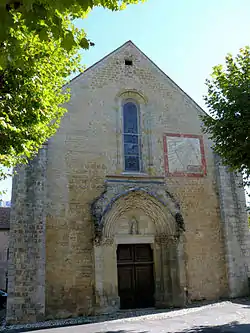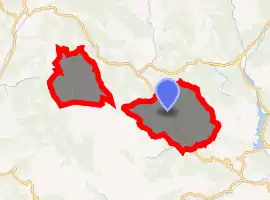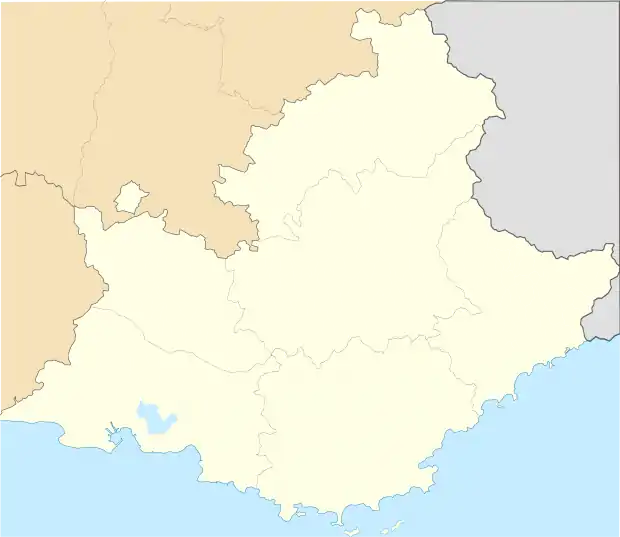Senez
Senez is a commune in the Alpes-de-Haute-Provence department in southeastern France.
Senez | |
|---|---|
 The cathedral of Our Lady of the Assumption, in Senez | |
 Coat of arms | |
Location of Senez 
| |
 Senez  Senez | |
| Coordinates: 43°54′52″N 6°24′28″E | |
| Country | France |
| Region | Provence-Alpes-Côte d'Azur |
| Department | Alpes-de-Haute-Provence |
| Arrondissement | Castellane |
| Canton | Riez |
| Government | |
| • Mayor (2008–2014) | Gilles Durand |
| Area 1 | 70.27 km2 (27.13 sq mi) |
| Population (2017-01-01)[1] | 167 |
| • Density | 2.4/km2 (6.2/sq mi) |
| Time zone | UTC+01:00 (CET) |
| • Summer (DST) | UTC+02:00 (CEST) |
| INSEE/Postal code | 04204 /04330 |
| Elevation | 748–1,720 m (2,454–5,643 ft) (avg. 780 m or 2,560 ft) |
| 1 French Land Register data, which excludes lakes, ponds, glaciers > 1 km2 (0.386 sq mi or 247 acres) and river estuaries. | |
Ecclesiastical history
Marcellus I, the first known bishop of Senez, attended the Council of Agde in 506; nevertheless, Senez must have been an episcopal city as early as 439.
Jean IV Soanen, the Oratorian, noted for his opposition to the Bull "Unigenitus", was Bishop of Senez from 1696 until the time of his deposition in 1727.
By the Concordat of 1801, the diocese of Digne was made to include the two departments of the Hautes-Alpes and Basses Alpes, in addition to the former diocese of Digne, the archdiocese of Embrun, the dioceses of Gap, Sisteron and Senez, a very considerable part of the diocese of Glandèves and diocese of Riez, and fourteen parishes in the Archdiocese of Aix and the Diocese of Apt.
In 1822 Gap was made an episcopal see and, thus divested of the department of the Hautes Alpes, the present diocese of Digne covers the territory formerly included in the dioceses of Digne, Senez, Glandèves, Riez, and Sisteron.
Population
|
|
References
- "Populations légales 2017". INSEE. Retrieved 6 January 2020.
 This article incorporates text from a publication now in the public domain: Herbermann, Charles, ed. (1913). Catholic Encyclopedia. New York: Robert Appleton Company. Missing or empty
This article incorporates text from a publication now in the public domain: Herbermann, Charles, ed. (1913). Catholic Encyclopedia. New York: Robert Appleton Company. Missing or empty |title=(help)
| Wikimedia Commons has media related to Senez. |